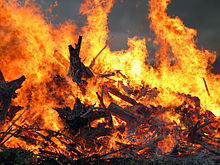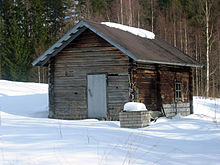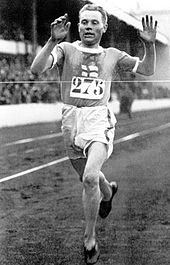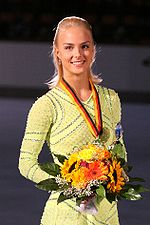- Culture of Finland
-
The culture of Finland combines indigenous heritage, as represented for example by the country's Uralic national language Finnish, and the sauna, with common Nordic and European culture. Because of its history and geographic location Finland has been influenced by the adjacent areas' various Finnic, Baltic and Germanic peoples as well as the former dominant powers Sweden and Russia. Finnish culture may be seen to build upon the relatively ascetic environmental realities, traditional livelihoods and a heritage of egalitarianism, (see e.g.: Everyman's right and universal suffrage) and the traditionally widespread ideal of self-sufficiency (see, e.g.: Summer cottage).
There are still cultural differences between Finland's regions, especially minor differences in accents and vocabulary. Minorities, some of which enjoy a status recognised by the state, such as the Sami, Swedish-speaking Finns, Romani, Jews, and Tatar, maintain their own cultural characteristics. Many Finns are emotionally connected to the countryside and nature, as large scale urbanisation is a relatively recent phenomenon.
Contents
Historical main aspects
 Prehistoric red ochre painted rock art of moose, human figures, and boats in Astuvansalmi, Finland from ca. 3800–2200 BC.
Prehistoric red ochre painted rock art of moose, human figures, and boats in Astuvansalmi, Finland from ca. 3800–2200 BC.
Following the recession of the Scandinavian ice sheet, which covered most of northern Europe, from Great Britain to Moscow, around 8000 BC, peoples began arriving in what is today Finland presumably mainly from the south and east although recent archaeological finds reveal a presence of the north-western Komsa culture in Finnish north equally old to the earliest finds on the Norwegian coast.[1]
The area of Finland belonged to the people northeastern European Kunda culture until around 5000 BC and Comb Ceramic culture from about 4200–2000 BC. The Kiukainen culture on the southwestern coast of Finland showed the 1200 AD.
From 1100 to 1200, the crown of Sweden started to incorporate Finland. However, Novgorod also attempted to gain control. Several wars were fought between Sweden and Novgorod and later Muscovy and Russia between the 1400 and 1700. In 1721, the Nystad Peace Treaty was signed ending Swedish dominance in the Baltic region. In 1809, Finland was annexed by Russia. From 1809 to 1917, Finland was a Grand Duchy with the Russian Czar as the constitutional monarch. [3] Karelia, where most of the Russo-Swedish conflicts occurred, was influenced by both cultures though mostly it remained peripheral to both epicentres of power. The verses in the Kalevala originate mainly from Karelia and Ingria.
The 19th century brought a feeling of national Romanticism and Nationalism throughout Europe. Finland's nationalism also grew where cultural identity and control of their land became a priority. Expression of Finnish identity by the University docent, A. I. Arwidsson (1791–1858), became an often quoted Fennoman credo: "Swedes we are not / no-longer, Russians we do not want to become, let us therefore be / become Finns."[2] Nationalism heightened and resulted in a declaration of independence from Russia on December 6, 1917, Finnish Independence Day. Notably, nationalists did not consider the Swedish-speakers members of a different (Swedish) nation; in fact, many Fennomans came from a Swedish-speaking family.
People
The Finnish-speaking part of the population are called Finns, possibly including a subculture of Swedish-speaking Finns. Finns are somewhat genetically distinct from other Europeans. The major Y-haplogroup in Finland is haplogroup N. Y-haplogroup I is another haplogroup prevalent in Finland. The Finnish language is not an Indo-European language, and belongs to Uralic family of languages. Finns are traditionally divided to subgroups (heimo) according to dialect, but these groupings have only a minor importance due to 20th century urbanization and internal migration.
The Finnish society encourages equality and liberalism with a popular commitment to the ideals of the welfare state; discouraging disparity of wealth and division into social classes. Everyman's right (Ministry of Environment, 1999) is a philosophy carried over from ancient times. All citizens have access to public and private lands for agrarian activities or leisure. Finns value being close to nature, the agricultural roots are embedded in the rural lifestyle. Finns are also nationalistic, as opposed to self-identification with ethnicity or clan.
Religion began as paganism, mythology and magic. The traditions were partly indigenous, but also influenced by Norse paganism. Song magic and bear worship are distinctive marks of the ancient religion. However, modernization ended the traditions ultimately in the first decade of the 20th century. Christianity entered Finnish culture in the 12th century [4]. Today, 80.6% of Finns belong to the Evangelical Lutheran Church[5] and 1.1% belong to the Finnish Orthodox Church[6]. In general, Finns are secular in their views.
With the emergence of reform, the Compulsory Education Act made education a civil right and available to all citizens, except for tertiary education, which is free of charge and admissions are based strictly on test scores. The beliefs of the Finns are future employment security necessitating higher education in today's increasingly technological world (Kyr, M. & Nyysol, K., 2006).
Native subcultures
Subcultures have been a part of Finnish history. The largest subculture is the Swedish-speaking Finns. This group does have unique traditions distinct from the mainstream Finnish-speaking ones, but does not live in a different society. The group has various origins, both from language switching and from immigration.
The Lapland region of the North holds the Sami population. Up to around 1500, the Sami were mainly fishermen and trappers, usually in a combination, leading a nomadic lifestyle decided by the migrations of the reindeer. Traditionally, Sami people engaged in fishing, trapping and herding reindeer. They have traditionally organized their societies differently from the Finns due to their nomadic lifestyle. Their native language is not Finnish, but one of the three Sami languages spoken in Finland. However, modern times have brought most Sami to urban areas, where they assimilate to mainstream society and speak Finnish. 10% of Sami continue herding in Northern Finland. Currently, the Sami are a 5% minority in their native Finnish Lapland.
Another nomadic group is the Finnish Gypsies who have existed since the 17th century. For centuries Gypsy men were horse traders, whereas in the post-war era they have turned to horse breeding and dealing in automobiles and scrap metal. Women traditionally engage in fortune telling and hand crafts. Gypsies have been the target of harassment and discrimination in Finland. "A permanent Advisory Commission on Gypsy Affairs was set up in 1968, and in 1970 racial discrimination was outlawed through an addition to the penal code. The law punished blatant acts such as barring Gypsies from restaurants or shops or subjecting them to unusual surveillance by shopkeepers or the police."[3] Today, financial aid is provided to improve the standard of living for 5,000–6,000 Finnish Gypsies.
Family structure
The Finnish family life is usually understood to be centered on the nuclear family, rather than the extended family. There are usually one or two children in a family. Traditionally, men were the wage-earners and women remained in the home and care for children. However, since the Second World War, gender roles have changed. Today, both men and women are dual wage-earners. The welfare system allows for generous parental leave with income-based benefits (Leitner, A. & Wroblewski, A., 2006). Finnish parents have the option to take partial or total leave they are entitled to. A majority of mothers opt to take longer leave, up to one year. Finland's divorce rate is 51% of marriages being dissolved (Statistics Finland, updated 5/07). Cohabitation is also common.
Youth seek independence and typically move from their parents' residence around the age of twenty and relocate to student accommodation or apartments. Females tend to leave the family home earlier in pursuit of education. Males remain in the home longer due to obligations to the military. Members of the extended family typically live apart.
Festivities and Traditions
Finnish holidays are similar to the Western Christian calendar and Protestant traditions. Holidays and traditions are a blend of the thousand-year old Christian presence and vestiges of old Finnish pagan traditions.
Notable among these is Juhannus, the Finnish Midsummer. A majority of Finns retreat to summer cottages (mökki) on any one of Finland's numerous lakes. Depending on the region, a bonfire at midnight celebrates the summer solstice, and in Åland, the Swedish-originated tradition of dancing around the Maypole is observed. The midsummer traditions also include different versions of pairing magic and folklore in the festivities.
The Finnish Christmas, Joulu, follows traditions of Christmas trees and the Advent calendars. Holidays start on the 23rd of December. Gift giving occurs on Christmas Eve with a visit from Joulupukki (Father Christmas, Santa Claus). Traditional meals are typically only eaten on Christmas followed by sauna. Christmas Day is reserved for a "quiet day"[4] and the holidays end after the 26th, St. Stephen's Day (tapaninpäivä).
Easter is a combination of Christian and Pagan customs. Either on Palm Sunday or the Holy Saturday, children dress up as witches (noita) and go from door to door, giving away daffodil adorned branches of willow in exchange for sweets. This is similar to the United States celebration of Halloween. Burning Easter bonfires is a Pagan custom meant to keep witches at bay.
Vappu, or May Day is a national holiday, an event for Finns to emphatically welcome spring after several months of little daylight. It can be compared to Mardi Gras with parades and parties. Traditionally, the event begins on the eve of Vappu by former and current students putting on their student caps (graduation cap).
Finnish Independence Day is the 6th of December and a national holiday.
Sauna is a steam bath practiced widely in Finland. The word is of Proto-Finnish origin (found in Finnic and Sámi languages) dating back 7,000 years.[5] The sauna's purpose is to bathe, and the heat (either dry or steam) opens pores in the skin and thoroughly cleanses the body. Cedar or birch branches can be tapped along the body to stimulate blood circulation. The sauna soothes sore and aching muscles. The Finns often use and have used the sauna to recover from hard physical labor. Sauna culture dictates subdued speech and time for thought to soothe the mind. Sauna is not to be rushed as it is essential to spiritual living. The structure of the sauna began as a small log building partially buried in the earth. A "smoke sauna" was used to cure meats in pre-industrial years as well as, to bathe or a sterile environment for childbirth, but this tradition has declined in favor of a modern invention, the continuously heated sauna, which is hotter, cleaner and faster to heat up. In Finnish saunas, temperature is set to about 60–100 °C, and small amounts of water thrown on rocks atop the stove emit steam, which produces a heat sensation. Some Finns prefer the "dry sauna" using very little steam, if any. Traditional sauna includes the process of perspiring and cooling several times. A part of the cooling process may be a swim in the lake before returning to the sauna for an additional sweat.
Similar steam baths have been part of European tradition elsewhere as well, but the sauna has survived best in Finland, in addition to Sweden, Estonia, Russia, Norway, and parts of the United States and Canada. Moreover, nearly all Finnish houses have either their own sauna, or in multistory apartment houses, a timeshared sauna. Public saunas were previously common, but the tradition has declined when saunas have been built nearly everywhere (private homes, municipal swimming halls, hotels, corporate headquarters, gyms, etc.).
Finland has a great amount of summer festivals, the biggest being music festivals.
Literature
Though Finnish written language could be said to exist since Mikael Agricola translated the New Testament into Finnish in the 16th century as a result of the Protestant Reformation, few notable works of literature were written until the 19th century, which saw the beginning of a Finnish national Romantic Movement. This prompted Elias Lönnrot to collect Finnish and Karelian folk poetry and arrange and publish them as Kalevala, the Finnish national epic. The era saw a rise of poets and novelists who wrote in Finnish, notably Aleksis Kivi and Eino Leino.
After Finland became independent there was a rise of modernist writers, most famously Mika Waltari. Frans Eemil Sillanpää was awarded the Nobel Prize in Literature in 1939 – so far the only one for a Finnish author. The second World War prompted a return to more national interests in comparison to a more international line of thought, characterized by Väinö Linna. Literature in modern Finland is in a healthy state, with detective stories enjoying a particular boom of popularity. Ilkka Remes, a Finnish author of thrillers, is very popular.
Visual arts
Finns have made major contributions to handicrafts and industrial design. Finland's best-known sculptor of the 20th century was Wäinö Aaltonen, remembered for his monumental busts and sculptures. Finnish architecture is famous around the world. Among the top of the 20th century Finnish architects to win international recognition are Eliel Saarinen (designer of the widely recognised Helsinki Central railway station and many other public works) and his son Eero Saarinen. Alvar Aalto, who helped bring the functionalist architecture to Finland, is also famous for his work in furniture and glassware
Music
Folk music
Much of the music of Finland is influenced by traditional Karelian melodies and lyrics, as comprised in the Kalevala. Karelian culture is perceived as the purest expression of the Finnic myths and beliefs, less influenced by Germanic influence, in contrast to Finland's position between the East and the West. Finnish folk music has undergone a roots revival in recent decades, and has become a part of popular music.
Sami music
The people of northern Finland, Sweden and Norway, the Sami, are known primarily for highly spiritual songs called Joik. The same word sometimes refers to lavlu or vuelie songs, though this is technically incorrect.
Classical and opera
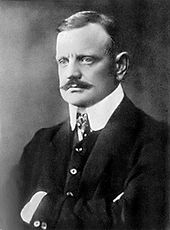 The Finnish composer Jean Sibelius (1865–1957), a significant figure in the history of classical music.
The Finnish composer Jean Sibelius (1865–1957), a significant figure in the history of classical music.
The first Finnish opera was written by the German composer Fredrik Pacius in 1852. Pacius also wrote Maamme/Vårt land (Our Land), Finland's national anthem. In the 1890s Finnish nationalism based on the Kalevala spread, and Jean Sibelius became famous for his vocal symphony Kullervo. He soon received a grant to study runo singers in Karelia and continued his rise as the first prominent Finnish musician. In 1899 he composed Finlandia, which played its important role in Finland gaining independence. He remains one of Finland's most popular national figures and is a symbol of the nation.
Today, Finland has a very lively classical music scene. Finnish classical music has only existed for about a hundred years, and many of the important composers are still alive, such as Magnus Lindberg, Kaija Saariaho, Aulis Sallinen and Einojuhani Rautavaara. The composers are accompanied by a large number of great conductors such as Sakari Oramo, Mikko Franck, Esa-Pekka Salonen, Osmo Vänskä, Jukka-Pekka Saraste, Susanna Mälkki and Leif Segerstam. Some of the internationally acclaimed Finnish classical musicians are Karita Mattila, Soile Isokoski, Kari Kriikku, Pekka Kuusisto, Réka Szilvay and Linda Brava.
Popular music
Modern Finnish popular music includes a renowned heavy metal music scene, in common with other Nordic countries, as well as a number of prominent rock bands, jazz musicians, hip hop performers, pop music and dance music acts such as Bomfunk MCs, Darude and Waldo's People. The producer JR Rotem, who has a Finnish and Israeli descent, is common in a lot of Finnish hit songs and in America. Finnish electronic music such as the Sähkö Recordings record label enjoys underground acclaim. Iskelmä (coined directly from the German word Schlager, meaning hit) is a traditional Finnish word for a light popular song. Finnish popular music also includes various kinds of dance music; tango, a style of Argentine music, is also popular. One of the most productive composers of popular music was Toivo Kärki, and the most famous singer Olavi Virta (1915–1972). Among the lyricists, Sauvo Puhtila (born 1928), Reino Helismaa (died 1965) and Veikko "Vexi" Salmi are a few of the most notable writers. The composer and bandleader Jimi Tenor is well known for his brand of retro-funk music.
Dance music
Notable Finnish dance and electronic music artists include Jori Hulkkonen, Darude, JS16, DJ Proteus, Fanu, DJ Muffler, trance duo Super8 & Tab and DJ Orkidea. Finnish dance music is also known for Suomisaundi, a kind of freestyle psychedelic trance that originated in Finland around the mid 1990s.
Rock and heavy metal music
The Finnish rock music scene emerged in the 1960, pioneered by artists such as Blues Section and Kirka. In the 1970s Finnish rock musicians started to write their own music instead of translating international hits into Finnish. During the decade some progressive rock groups, such as Tasavallan Presidentti and Wigwam, gained respect abroad but failed to make a commercial breakthrough outside Finland. This was also the fate of the rock and roll group, Hurriganes. The Finnish punk scene produced some internationally respected names including Terveet Kädet in 1980s. Hanoi Rocks was a pioneering 1980s glam rock act that left perhaps a deeper mark in the history of popular music than any other Finnish group by being an influence for groups such as Guns 'n' Roses.
In 1990s Finnish rock and metal music started to gain international fame with such bands as The 69 Eyes, Amorphis, Children of Bodom, Ensiferum, Norther, Wintersun, HIM, Impaled Nazarene, Lordi, Negative, Nightwish, The Rasmus, Sentenced, Sonata Arctica, and Stratovarius. In the late 1990s the cello metal group Apocalyptica played Metallica cover versions as cello quartettos and sold half a million records worldwide. Some of the Finland's most domestically popular rock groups are CMX and Eppu Normaali. Finland also helped bring Folk Metal music more popularity, through bands such as Turisas and Finntroll.
In 2000s Finnish rock bands started to sell well internationally. The Rasmus finally captured Europe (and other places, like South America) in 2000s. Their 2003 album Dead Letters sold 1.5 million units worldwide and garnered them eight gold and five platinum albums designations. But so far the most successful Finnish band in the United States has been HIM; they were the first band from Finland to ever sell an album that was certified gold by the RIAA. Most recently, the Finnish hard rock/heavy metal band Lordi won the 2006 Eurovision Song Contest with a record 292 points, giving Finland its first ever victory. Rock bands such as The 69 Eyes and Reflexion enjoy cult following abroad.
Tuska Open Air Metal Festival, one of the largest open-air heavy metal music festivals in the world, is held annually in Kaisaniemi, Helsinki.[6] Ruisrock and Provinssirock are the most famous rock festivals held in Finland.
Cinema
Finland has a growing film industry with a number of famous directors such as Aki Kaurismäki, Timo Koivusalo, Aleksi Mäkelä and Klaus Härö. Hollywood film director/producer Renny Harlin (born Lauri Mauritz Harjola) was born in Finland.
Media and communications
See also: Communications in Finland, List of newspapers in Finland, and List of Finnish television stationsFinland is one of the most advanced information societies in the world. There are 200 newspapers; 320 popular magazines, 2,100 professional magazines and 67 commercial radio stations, with one nationwide, five national public service radio channels (three in Finnish, two in Swedish, one in Sami); digital radio has three channels. Four national analog television channels (two public service and two commercial) were fully replaced by five public service and three commercial digital television channels on September 1, 2007.
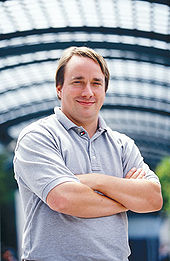 Linus Torvalds, a famous Finnish software engineer, best known for initiating the development of the kernel of the Linux operating system.
Linus Torvalds, a famous Finnish software engineer, best known for initiating the development of the kernel of the Linux operating system.
Each year around 15–20 feature films are produced,[7] 12,000 book titles published and 12 million records sold. 79 percent of the population use the Internet.[8][9]
Finns, along with other Nordic people and the Japanese, spend the most time in the world reading newspapers. The most read newspaper in Finland is Helsingin Sanomat, with a circulation of 412,000.[10] The media group Sanoma behind Helsingin Sanomat also publishes the tabloid Ilta-Sanomat and commerce-oriented Taloussanomat. It also owns the Nelonen television channel. Sanoma's largest shareholders are Aatos Erkko and his family. The other major publisher Alma Media publishes over thirty magazines, including newspaper Aamulehti, tabloid Iltalehti and commerce-oriented Kauppalehti. Finland has been at the top of the worldwide Press Freedom Ranking list every year since the publication of the first index by Reporters Without Borders in 2002.[11]
Finland's National Broadcasting Company YLE is an independent state-owned company. It has five television channels and 13 radio channels in two national languages. YLE is funded through a television license and private television broadcasting license fees. Ongoing transformation to digital TV broadcasting is in progress — analog broadcasts ceased on the terrestrial network 31 August 2007 and will cease on cable at the end of February 2008. The most popular television channel MTV3 and the most popular radio channel Radio Nova are owned by Nordic Broadcasting (Bonnier and Proventus Industrier).
The people of Finland are accustomed to technology and information services. The number of cellular phone subscribers as well as the number of Internet connections per capita in Finland are among the highest in the world. According to the Ministry of Transport and Communications, Finnish mobile phone penetration exceeded fifty percent of the population as far back as August 1998 – first in the world – and by December 1998 the number of cell phone subscriptions outnumbered fixed-line phone connections. By the end of June 2007 there were 5.78 million cellular phone subscriptions, or 109 percent of the population.[12]
Another fast-growing sector is the use of the Internet. Finland had more than 1.52 million broadband Internet connections by the end of June 2007, i.e., about 287 per 1,000 inhabitants.[12] The Finns are not only connected; they are heavy users of Internet services. All Finnish schools and public libraries have for years been connected to the Internet. Finland is the country with the fastest internet connection in the world, with speeds averaging around 40 Mbs.
Cuisine
Traditional Finnish cuisine is a combination of European, Fennoscandian and Western Russian elements; table manners are European. The food is generally simple, fresh and healthy. Fish, meat, berries and ground vegetables are typical ingredients whereas spices are not common due to their historical unavailability. In years past, Finnish food often varied from region to region, most notably between the west and east. In coastal and lakeside villages, fish was a main feature of cooking, whereas in the eastern and also northern regions, vegetables and game were more common. In Finnish Lapland, reindeer was also important. The prototypical breakfast is oatmeal or other continental-style foods such as bread. Lunch is usually a full warm meal, served by a canteen at workplaces. Dinner is eaten at around 17.00 to 18.00 at home, and it is also common to have a supper later in the evening.
Modern Finnish cuisine combines country fare and haute cuisine with contemporary continental cooking style. Today, spices are a prominent ingredient in many modern Finnish recipes, having been adopted from the east and west in recent decades.
Public holidays
All official holidays in Finland are established by acts of Parliament. The official holidays can be divided into Christian and secular holidays, although some of the Christian holidays have replaced holidays of pagan origin. The main Christian holidays are Christmas, Epiphany, Easter, Ascension Day, Pentecost, and All Saints Day. The secular holidays are New Year's Day, May Day, Midsummer Day, and the Independence Day. Christmas is the most extensively celebrated holiday: usually at least December 24th to 26th are holidays.
Sports
 2007 Formula One World Champion Kimi Räikkönen celebrating victory at the 2007 Brazilian Grand Prix.
2007 Formula One World Champion Kimi Räikkönen celebrating victory at the 2007 Brazilian Grand Prix.
Various sporting events are popular in Finland. Pesäpallo (reminiscent of baseball) is the national sport of Finland, although the most popular sports in Finland in terms of media coverage are Formula One, ice hockey and football. The Finnish national ice hockey team is considered one of the best in the world. During the past century there has been a rivalry in sporting between Finland and Sweden, mostly in ice hockey and athletics (Finland-Sweden athletics international). Jari Kurri and Teemu Selänne are the two Finnish-born ice hockey players to have scored 500 goals in their NHL careers. Football (the game known in the USA as soccer) is also popular in Finland, though the national football team has never qualified for a finals tournament of the World Cup or the European Championships. Jari Litmanen and Sami Hyypiä are the most internationally renowned of the Finnish football players.
Relative to its population, Finland has been a top country in the world in automobile racing, measured by international success. Finland has produced three Formula One World Champions – Keke Rosberg (Williams, 1982), Mika Häkkinen (McLaren, 1998 and 1999) and Kimi Räikkönen (Ferrari, 2007). Along with Räikkönen, the other Finnish Formula One driver currently active is Heikki Kovalainen (McLaren). Rosberg's son, Nico Rosberg (Williams), is also currently driving, but under his mother's German nationality. Other notable Finnish Grand Prix drivers include Leo Kinnunen, JJ Lehto and Mika Salo. Finland has also produced most of the world's best rally drivers, including the ex-WRC World Champion drivers Marcus Grönholm, Juha Kankkunen, Hannu Mikkola, Tommi Mäkinen, Timo Salonen and Ari Vatanen. The only Finn to have won a road racing World Championship, Jarno Saarinen, was killed in 1973 while racing.
Among winter sports, Finland has been the most successful country in ski jumping, with former ski jumper Matti Nykänen being arguably the best ever in that sport. Most notably, he won five Olympic medals (four gold) and nine World Championships medals (five gold). Among currently active Finnish ski jumpers, Janne Ahonen has been the most successful. Kalle Palander is a well-known alpine skiing winner, who won the World Championship and Crystal Ball (twice, in Kitzbühel). Tanja Poutiainen has won an Olympic silver medal for alpine skiing, as well as multiple FIS World Cup races.
Some of the most outstanding athletes from the past include Hannes Kolehmainen (1890–1966), Paavo Nurmi (1897–1973) and Ville Ritola (1896–1982) who won eighteen gold and seven silver Olympic medals in the 1910s and 1920s. They are also considered to be the first of a generation of great Finnish middle and long-distance runners (and subsequently, other great Finnish sportsmen) often named the "Flying Finns". Another long-distance runner, Lasse Virén (born 1949), won a total of four gold medals during the 1972 and 1976 Summer Olympics.
Also, in the past, Riku Kiri, Jouko Ahola and Janne Virtanen have been the greatest strength athletes in the country, participating in the World's Strongest Man competition between 1993 and 2000.
The 1952 Summer Olympics, officially known as the Games of the XV Olympiad, were held in 1952 in Helsinki, Finland. Other notable sporting events held in Finland include the 1983 and 2005 World Championships in Athletics, among others.
Some of the most popular recreational sports and activities include floorball, Nordic walking, running, cycling and skiing.
List of iconic cultural aspects
- List of Finns
- Suuret suomalaiset – a list of the "100 Greatest Finns" of all time as voted by the Finnish people in 2004.
Below are listed some of the characteristics of Finnishness. The term "Finnishness" is often referred to as the national identity of the Finnish people and its culture.
-
Finnish Maiden a figure of national personification symbolising Finland Kalevala the national epic of Finland, and Finnish mythology in general Kantele traditional musical instrument Mämmi traditional Easter food Kalakukko traditional Savonian food Mustamakkara traditional blood sausage from Tampere Karelian pasties traditional pasties from the region of Karelia Joulupukki Father Christmas/Santa Claus Jean Sibelius one of the most popular national figures (composer of the symphonic poem Finlandia) Sauna a Finnish national institution (see also Finnish sauna) Sisu will, determination, perseverance, mental fortitude Perkele swear word (see Finnish profanity) Puukko traditional Finnish style woodcraft belt-knife Talkoot community work Ice swimming swimming in a body of water with a frozen crust of ice Nordic walking a recreational sport first popularized in Finland Salmiakki salty liquorice Sahti traditional beer Koskenkorva Finnish vodka Reilu meininki fair dealing Flying Finn a nickname given to notable Finnish sportsmen (originated with Olympic medalist Hannes Kolehmainen)
See also
- Architecture of Finland
- Holidays in Finland, Flag days in Finland, Namesdays in Finland
- List of Finns
References
- ^ PEOPLE, MATERIAL CULTURE AND ENVIRONMENT IN THE NORTH Proceedings of the 22nd Nordic Archaeological Conference, University of Oulu, 18–23 August 2004 Edited by Vesa-Pekka Herva GUMMERUS KIRJAPAINO [1]
- ^ Swedish form: "Svenskar äro vi icke längre, ryssar vilja vi icke bli, låt oss alltså bli finnar." Finnish form: "Ruotsalaisia emme ole, venäläisiksi emme tule, olkaamme siis suomalaisia".
- ^ The Library of Congress Country Studies; CIA World Factbook
- ^ A time of tradition ThisisFINLAND
- ^ [2] Seeking the real Finnish Sauna — thisisFINLAND
- ^ "Tuska Open Air Metal Festival". http://www.tuska-festival.fi/. Retrieved 2007-07-25.
- ^ "The Finnish Film Foundation: Facts and Figures 2007". http://www.ses.fi/dokumentit/Tilastot%202007.pdf.
- ^ "Internet used by 79 per cent of the population at the beginning of 2007". Statistics Finland. http://www.stat.fi/til/sutivi/2007/sutivi_2007_2007-09-28_tie_001_en.html. Retrieved 2007-12-22.
- ^ "The Finnish Media". thisisFINLAND(Ministry for Foreign Affairs of Finland). http://finland.fi/public/default.aspx?nodeid=41808&contentlan=2&culture=en-US. Retrieved 2007-01-22.
- ^ "Circulation Statistics". The Finnish Audit Bureau of Circulations (Levikintarkastus Oy). http://www.levikintarkastus.fi/english/statistics.php. Retrieved 26 July 2009.
- ^ "Worldwide Press Freedom Index 2006". Reporters Without Borders. http://www.rsf.org/article.php3?id_article=19388. Retrieved 2007-01-22.
- ^ a b "Market Review 2/2007". Finnish Communications Regulatory Authority (FICORA). 2007-08-31. http://www.ficora.fi/attachments/englanti/5ruZDB5VP/Files/CurrentFile/Market_review_2_2007.pdf. Retrieved 2007-09-04.
http://uralica.com/earlyfin.htm http://www.ut.ee/Ural/wel.html http://www.kwintessential.co.uk/resources/global-etiquette/finland-country-profile.html Statistics Finland, updated 5/07 The World Book Encyclopedia (1990). Finland (Vol. 7) p 117.
External links
- What Finland can Teach America About True Luxury by Trevor Corson, The Christian Science Monitor, May 1, 2009
- The Finnuit - Finnish Culture and the Religion of Uniqueness by Edwahird Dutton, 2009
- Discussion about Finnish Culture
 Finland topics
Finland topicsHistory Early Finnish wars · Great Northern War · Grand Duchy of Finland · Finnish famine of 1866–1868 · Russification of Finland · Finnish Declaration of Independence · Finnish Civil War · October Revolution · Finland's language strife · Military history of Finland during World War II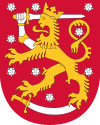
Politics and
governmentGeography Economy Military Demographics Education · Ethnic groups · Languages · Religion · Administrative divisions · Cities · People · HealthcareMedia Culture Symbols Culture of Europe Sovereign
states- Albania
- Andorra
- Armenia
- Austria
- Azerbaijan
- Belarus
- Belgium
- Bosnia and Herzegovina
- Bulgaria
- Croatia
- Cyprus
- Czech Republic
- Denmark
- Estonia
- Finland
- France
- Georgia
- Germany
- Greece
- Hungary
- Iceland
- Ireland
- Italy
- Kazakhstan
- Latvia
- Liechtenstein
- Lithuania
- Luxembourg
- Macedonia
- Malta
- Moldova
- Monaco
- Montenegro
- Netherlands
- Norway
- Poland
- Portugal
- Romania
- Russia
- San Marino
- Serbia
- Slovakia
- Slovenia
- Spain
- Sweden
- Switzerland
- Turkey
- Ukraine
- United Kingdom
- (England
- Northern Ireland
- Scotland
- Wales)
- Vatican City
States with limited
recognition- Abkhazia
- Kosovo
- Nagorno-Karabakh
- Northern Cyprus
- South Ossetia
- Transnistria
Dependencies
and other territories- Åland
- Faroe Islands
- Gibraltar
- Guernsey
- Jan Mayen
- Jersey
- Isle of Man
- Svalbard
Other entities - European Union
Categories:- Finnish culture
Wikimedia Foundation. 2010.





